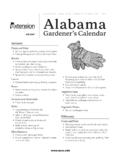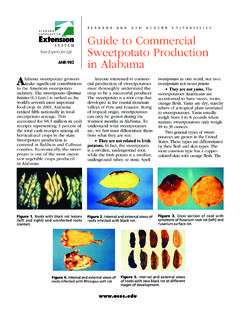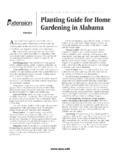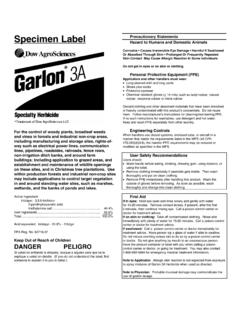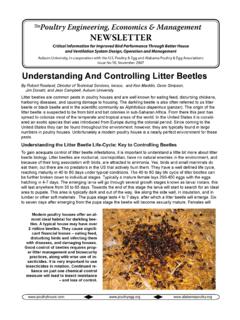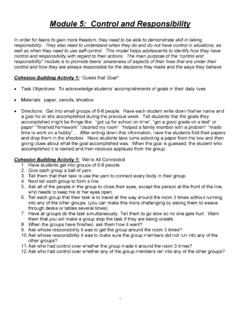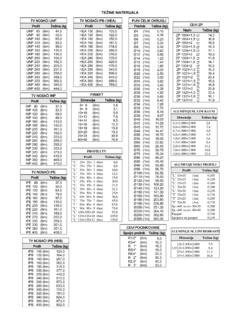Transcription of ALABAMA A&M AND AUBURN UNIVERSITIES …
1 ALABAMA A&M AND AUBURN UNIVERSITIES . polioencephalomalacia Your Experts for Life UNP-65. (Goat Polio). Introduction polioencephalomalacia (PEM) is a common neuronal death. In order for PEM to occur, metabolic disorder characterized by neuro- thiaminases I and II must be produced to inhibit muscular alterations of goats that are thiamine thiamin-dependent biochemical reactions. deficient. This disorder may be acute or sub- acute in nature. Adults and young animals are A higher production of thiaminase in the equally at high risk for developing the disorder. rumen is often due to sudden dietary changes, Goat polio is usually seen in animals that are whereby diets are rich in concentrated ration under a high nutritional management condition and low in roughage.
2 Increased thiaminase such as feedlots, or animals on lush pasturage production can also result from prolonged fed with highly concentrated rations. treatment with antiprotozoa substances such as CORID (amprolium), the administration of Thiamine deficiency usually implies the dewormers, and animals grazing in recently depletion of carbohydrates in brain cells that fertilized pasture, and in animals exposed to manifest as a neurological disorder. Thiamine high sulfur intake. (Vitamin B1) is produced by the bacteria and protozoa of the rumen under normal environ- mental conditions. Any change in the ruminal Clinical Signs environment will affect the natural microorganismal production of thiamine, in- Clinical signs of goat polio are associated crease the degradation of thiamine, or prevent with cerebral edema, cerebellar, and herniation thiamine from functioning properly in sheep of the brain, and the death of brain cells con- and goats.
3 Trolling motor and visual functions. Convulsions occur in 2 to 5-minute intervals. In highly grain-fed animals, thiamin mol- ecules produced in the rumen can be inacti- Goats may be standing or lying down when vated or degraded by the thiaminases, enzy- having convulsions. Goats appear dull and matic proteins that catabolize thiamine. In the depressed and unable to coordinate muscular presence of excessive concentrated rations, movements. They may also show signs of thiaminase I is excessively produced by Bacillus increased aggression, muscle tremors, and sp. and Clostridium sporogenes. Thiaminase II temporary blindness that can last 2 to 3 weeks.
4 Is produced by B. aneurinolyticus. Both en- Body temperature, pulse, and respiration rates zymes are responsible for degrading thiamine. can be increased. Rumen motility is maintained Lower levels of thiamine will promote a lower normally. Other signs of PEM include opisthoto- supply of carbohydrates to the nerve cells, nos, a condition of abnormal posturing where causing central nervous system disorders, PEM, the head is thrown backward accompanied by and death. Thiamine is a cofactor in the me- rigidity, severe arching of the back, muscular tabolism of carbohydrates (sugars). The lack of contractions, and teeth grinding. As the condi- thiamine will induce a lower supply of carbohy- tion progresses, the animal becomes recumbent drates to the neurons in the brain.
5 The neurons with frequent convulsions, nystagmus (rapid require carbohydrates as an energy source involuntary movement of the eyeballs), blind- necessary for nerve function. The depletion of ness, and unaltered palpebral and pupillary carbohydrates causes alterations of the mecha- responses. nism of action of the nervous system and Diagnosis Diagnosis is based on clinical signs and In more severe cases where animals history of the herd management and laboratory present blindness, thiamine HCl should be given analysis. Laboratory analysis shows that the intravenously in mg/lb BW dosages at 4-6- levels of thiaminase, pyruvate in the urine, hour intervals until animals show improvement blood pyruvate, lactate levels, and pyruvate or every 3 hours for a total of five doses.
6 The kinase levels are all increased; transketolase administration of Dexamethasone to 1/0. activity values are lower in affected animals. mg/lb IM or SC is recommended to decrease endema and inflammation of the brain. Fluid Differential diagnosis consists of the exclu- therapy with dextrose solution intravenously or sion of other diseases and disorders of the subcutaneously, is also recommended. neuro-muscular systems such as caprine arthri- tis encephalitis, listeriosis, enterotoxemia, Prevention pregnancy toxemia, grain poisoning, plant poisoning, rabies, and tetanus. Observe sulfur intake: source of water and consumed dry matter. Provide feed with thiamine levels of.
7 Treatment, Prevention, and Control mg/kg of feed. Provide sufficient levels of roughage; pro- The response to treatment depends on the vide good quality pasture or hay as part of condition and extent of brain lesions. In the the diet. early stages of thiamine deficiency, animals will Monitor animals after you have adminis- respond promptly to treatment. In delayed tered antihelminths dewormers and/or diagnosis and treatment, full clinical recovery amprolium (Corid ). may not be possible. Administer thiamine HCl in Check sulfur content on water source and the dosage of to 10 mg/lb intravenously. forages. Animals will show improvement within minutes or a few hours.
8 In delayed diagnosis and treat- ment, full clinical recovery may not be possible. For animals that show slower signs of improve- ment, administer the dosage of thiamine HCl intramuscularly in 3- to 6-hour intervals. Consult your local veterinarian for disease treatment and prevention. 2 ALABAMA Cooperative Extension System References Brent, B. E., and Bartley, E. E. (September 1984). Thiamin and niacin in the rumen. Journal of Animal Science, 59(3), 813-822. Candau M, and Massengo J. (1982). Evidence of a thiamine deficiency in sheep fed maize silage. Annales de Recherches V t rinaires (Annals of Veterinary Research), 13(4), 329-340. Cushnie, G.
9 H., Richardson, A. J., Lawson, W. J., and Sharman, G. A. (November 24, 1979). Cerebrocortical necrosis in ruminants: Effect of thiaminase type 1-producing Clostridium sporogenes in lambs. Veterinary Record, 105(21), 480-482. Maxwell, J. A. (July 1980). polioencephalomalacia in a goat. Australian Veterinary Journal, 56(7), 352. Newsholme, S. J., and O'Neill, T. P. (1985). An outbreak of cerebrocortical necrosis ( polioencephalomalacia ) in goats. Journal of the South African Veterinary Association, 56(1), 37-38. The Merck Veterinarian Manual. (2006). polioencephalomalacia : Introduction (cerebrocortical necrosis). Whitehouse Station, NJ: Merck & Co.
10 , Inc. Rammell, C. G., and Hill, J. H. (June 1988). Blood thiamine levels in clinically normal goats and goats with suspected polioencephalomalacia . New Zealand Veterinary Journal, 36(2), 99-100. Smith, M. C. (1979). polioencephalomalacia in goats. Journal of the American Veterinary Medical Association, 174(12), 1328-1332. Thomas, K. W. (1986). The effect of thiaminase-induced subclinical thiamine deficiency on growth of weaner sheep. Veterinary Research Communication, 10(2), 125-141. Thomas, K. W. (1986). Oral treatment of polioencephalomalacia and subclinical thiamine deficiency with thiamine propyl disulphide and thiamine hydrochloride. Journal of Veterinary Pharmaco- logical Therapy, 9(4), 402-411.
